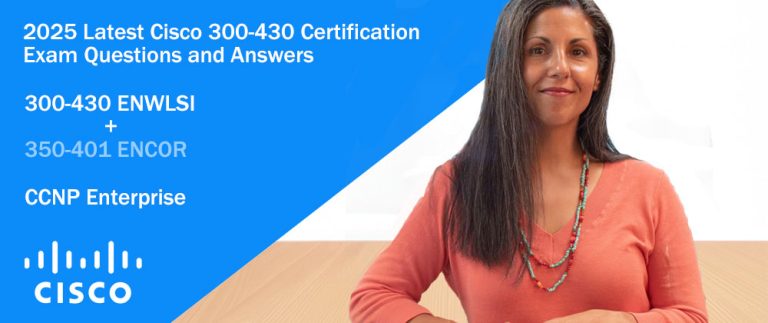Free Sharing Flydumps Cisco 642-845 exam questions and answers are constantly being revised and updated for relevance and accuracy.Many candidates has passed the Cisco 642-845 exam easily by training the new version.100% pass rate.
Exam A
QUESTION 1
What best describes an FXO interface?
A. analog trunks that provide the Survivable Remote Site Telephony (SRST) feature
B. analog trunks that provide VoIP gateway functionality
C. analog trunks that connect a gateway to plain old telephone service (POTS) device such as analog phones, fax machines, and legacy voice-mail systems
D. analog trunks that connect a gateway to a central office (CO) or private branch exchange (PBX)
Correct Answer: D Section: (none) Explanation
QUESTION 2
Which two steps are executed in the deployment of Cisco AutoQoS for Enterprise? (Choose two.)
A. The customer uses SNMP statistics to create the policy.
B. QoS policy templates are generated and installed on the interface.
C. RTP is used to generate the policy.
D. LLQ, cRTP, and LFI are used to automatically discover the policy.
E. The auto-generated policy is manually optimized before implementation.
F. Auto-discovery is used to determine what traffic is on the interface.
Correct Answer: BF Section: (none) Explanation
QUESTION 3
What are two of the three predefined classes for the Cisco SDM wizard? (Choose two.)
A. business-critical
B. high priority
C. middle class
D. voice
E. best effort
F. scavenger
Correct Answer: AE Section: (none) Explanation
Explanation/Reference:
QUESTION 4
Which two statements are true about the application of QoS in a converged network? (Choose two.)
A. End-to-end network delay times that exceed 50 ms for real-time traffic are considered unacceptable.
B. End-to-end network delay times that exceed 250 ms for real-time traffic are considered unacceptable.
C. End-to-end network delay is not a factor as long as the delay is consistent.
D. Some packet loss can be corrected by codec algorithms.
E. RSVP handles voice packet retransmission.
F. Fragmentation is a result of packet loss.
Correct Answer: BD Section: (none) Explanation
QUESTION 5
A GRE tunnel is configured between a local and a remote site. Where should the service policy be
applied to classify packets based on the pretunnel header?
A. In global configuration mode, apply the service policy and use the qos pre-classify command.
B. In global configuration mode, apply the service policy but do not use the qos pre-classify command.
C. Apply the service policy on the physical interface but do not use the qos pre-classify command.
D. Apply the service policy on the tunnel interface but do not use the qos pre-classify command.
E. Apply the service policy on the tunnel interface and use the qos pre-classify command.
Correct Answer: D Section: (none) Explanation
QUESTION 6
Which statement is true about the capabilities of a voice gateway router?
A. Voice gateways with analog interfaces need a gatekeeper to convert analog signals into digital format before voice is encapsulated into IP packets.
B. Voice gateways need a gatekeeper to interconnect the VoIP networks with the PSTN network.
C. Voice gateways with Cisco Unified CallManager Express (CME) can permanently act as a call agent for IP phones.
D. Voice gateways equipped with a DSP module can take the role of the call agent during WAN failure.
Correct Answer: C Section: (none) Explanation
QUESTION 7
Which statement is true about the configuration of AutoQoS on a Frame Relay interface?
A. AutoQoS can be configured from a different subinterface if the DLCI is already assigned to one subinterface.
B. Multilink PPP (MLP) over Frame Relay must be manually configured on low speed DLCIs.
C. For low-speed Frame Relay DLCIs with Frame Relay-to-ATM Interworking, the AutoQoS cannot be configured if a virtual template is already configured for the DLCI.
D. AutoQoS can be configured on a Frame Relay DLCI only if a map class is attached to the DLCI.
Correct Answer: C Section: (none) Explanation
QUESTION 8
Refer to the exhibit. What type of interface will connect the voice gateway router R1 to the analog
phone and the fax machine?
A. The analog phone will be connected to the FXS port, and the fax machine will be connected to the FXO port on router R1.
B. The analog phone will be connected to the FXO port, and the fax machine will be connected to the FXS port on router R1.
C. Both devices will be connected to the FXS ports on router R1.
D. Both devices will be connected to the FXO ports on router R1.
E. Both devices will be connected to the E and M ports on router R1.
Correct Answer: C Section: (none) Explanation
Explanation/Reference:
QUESTION 9
What are two major sources of delay that can be managed by QoS in voice-enabled networks?
(Choose two.)
A. propagation delay
B. voice packet serialization delay
C. congested egress queues
D. header overhead
E. packets dropped because of CRC errors
Correct Answer: CD Section: (none) Explanation QUESTION 10
Which statement best describes the Cisco 2700 Location Appliance collection of location information
for wireless devices?
A. All Wi-Fi devices on the WLAN send directly received signal strength indication (RSSI) information to the Cisco Wireless Location Appliance through SNMP.
B. An AP collects RSSI information which is forwarded to wireless controllers through LWAPP. Wireless controllers forward aggregated RSSI to the location appliance through SNMP.
C. The APs collect received signal strength indication (RSSI) information from all Wi-Fi devices and forward the information to the Cisco Wireless Location Appliance through the LWAPP.
D. The Cisco WLAN controllers bypass the received signal strength indication (RSSI) information from all Wi-Fi devices to the Cisco Wireless Location Appliance through LWAPP.
Correct Answer: B Section: (none) Explanation
QUESTION 11
Which two statements about the DiffServ QoS model are true? (Choose two.)
A. DiffServ requires RSVP to set up a path through the network to accommodate the requested QoS.
B. Network traffic is identified by class, and the level of service is chosen for each class.
C. The DiffServ model relies on a fairly simple mechanism to provide QoS over a wide range of equipment.
D. RSVP enables the DiffServ model to provide end-to-end QoS.
E. The DiffServ model is more scalable than the IntServ model.
F. The flow-based approach of the DiffServ model is ideal for large scalable implementations such as the public Internet.
Correct Answer: BE Section: (none) Explanation
QUESTION 12
What are two features of WLSE-Express wireless management? (Choose two.)
A. centralized management for autonomous access points
B. centralized management for lightweight access points
C. centralized management that requires an external AAA server
D. centralized management with integrated AAA server
E. integration with the Location Appliance to expand real time tracking to 1500 devices for 30 days
F. integration with the Location Appliance to expand real time tracking to 2500 devices for 30 days
Correct Answer: AD Section: (none) Explanation
QUESTION 13
Which three statements are true about the application of QoS models? (Choose three.)
A. The DiffServ model requires applications to signal the network with QoS requirements.
B. The DiffServ model can be used to deliver QoS based upon IP precedence, or source and destination addresses.
C. The DiffServ model requires RSVP.
D. The best effort model is suitable for applications such as file transfer and e-mail
E. The IntServ model requires applications to signal the network with QoS requirements.
F. The IntServ model attempts to deliver a level of service based on the QoS specified by each packet
Correct Answer: BDE Section: (none) Explanation
QUESTION 14
Refer to the exhibit. The serial link that connects the two offices has a bandwidth of 128 kbps. What
could be done to set aside 64 kbps of bandwidth to transport VoIP traffic over the WAN link?
A. Apply the clock rate 64000 command on both serial interfaces connected to the WAN link.
B. Apply the bandwidth 64 command on both serial interfaces connected to the WAN link.
C. Apply the frame-relay voice-bandwidth 64000 command to enable the QoS Call Admission Control feature on the serial link.
D. Apply the max-conn 64 command on a perial peer basis on both sides of the serial link.
E. Apply the ip bandwidth-percent eigrp 1 64 command on both sides of the serial link.
F. Apply the auto-cost reference-bandwidth 64 command on both sides of the serial link.
Correct Answer: C Section: (none) Explanation QUESTION 15
Which three configuration tasks are required to successfully deploy NBAR to recognize TCP and UDP
stateful protocols? (Choose three.)
A. Over leased lines, use the multilink ppp command to reduce latency and jitter, and to create Distributed Link Fragmentation and interleaving.
B. Use the service-policy command to attach a traffic flow to an interface on the router.
C. Use the ip rsvp bandwidth command to set a strict upper limit on the bandwidth NBAR uses, and to guarantee admission of any flows.
D. Use the policy-map command to define one or more QoS policies (such as shaping, policing, and so on) to apply to traffic defined by a class map.
E. Use the random-detect dscp command to modify the default minimum and maximum thresholds for the DSCP value.
F. Use the class-map command to define one or more traffic classes by specifying the criteria by which traffic is classified.
Correct Answer: BDF Section: (none) Explanation
QUESTION 16
What is the most common cause of network congestion?
A. aggregation congestion occurring at the core layer where the different distribution layer devices feed traffic to the core-layer switches
B. speed mismatches when moving from a low-speed LAN environment to a higher speed WAN environment
C. flapping Ethernet interfaces caused by misconfigured LAN interfaces
D. flapping serial interfaces caused by misconfigured WAN interfaces
E. speed mismatches when moving from a high-speed LAN environment to a lower speed WAN environment
Correct Answer: E Section: (none) Explanation
QUESTION 17
What are two components of the Cisco Autonomous WLAN solution? (Choose two.)
A. WCS
B. WLSE
C. WLC
D. WDS
E. LWAPP
Correct Answer: BD Section: (none) Explanation
QUESTION 18
What are three security problems with Wi-Fi Protected Access (WPA)? (Choose three.)
A. WPA is based on the outdated IEEE 802.11i standard.
B. WPA uses RSN, which uses the same base encryption algorithm as RC4.
C. WPA requires a hardware upgrade that may not be supported by all vendors.
D. WPA uses TKIP, which uses the same base encryption algorithm as WEP.
E. WPA is susceptible to a DoS attack when it receives two packets in quick succession with bad MICs, forcing the AP to shut down the entire Basic Service Set (BSS) for one minute.
F. WPA is susceptible to a security weakness when preshared keys are used.
Correct Answer: DEF Section: (none) Explanation
QUESTION 19
Which three characteristics of the traffic flow are taken into consideration when the QoS-for-VPNs
feature (QoS pre-classify) provides packet classification and applies appropriate QoS service on tunnel
interfaces? (Choose three.)
A. IP precedence bits
B. DSCP bits
C. original port numbers
D. DE bits
E. source IP address
F. destination IP address
Correct Answer: CEF Section: (none) Explanation
QUESTION 20
Which two statements about the Wireless Location Appliance are true? (Choose two.)
A. A Wireless Location Appliance acts as a server to one or more Cisco WCSs. It collects, stores, and passes on data from its associated Cisco WLAN controllers.
B. Before using the Web interface, the initial configuration of the Wireless Location appliance must be done using the command-line interface (CLI).
C. The Cisco 2000, 2700, 4100, and 4400 are examples of Wireless Location Appliances.
D. The Wireless Location Appliance visually displays the location information of WLAN devices and forwards this information to third-party applications using the Simple Network Management Protocol (SNMP).
E. The Wireless Location Appliance visually tracks up to 15,000 WLAN devices and can store this information for 90 days.
Correct Answer: AB Section: (none) Explanation
CCNA 642-845 contains a powerful new testing engine that allows you to focus on individual topic areas or take complete, timed exams from CCNA Cisco 642-845.The assessment engine also tracks your performance and presents feedback on a module-by-module basis, providing question-by-question CCNA Cisco 642-845 to the text and laying out a complete study plan for review.CCNA Cisco 642-845 also includes a wealth of hands-on practice exercises and a copy of the CCNA Cisco 642-845 network simulation software that allows you to practice your CCNA Cisco 642-845 hands-on skills in a virtual lab environment.The CCNA Cisco 642-845 supporting website keeps you fully informed of any exam changes



